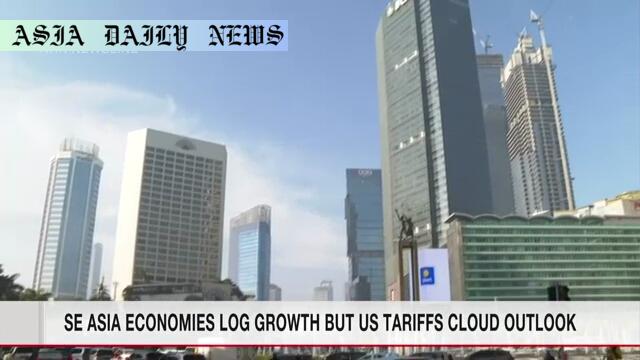Southeast Asia Economies are witnessing steady growth despite the looming burden of US tariffs on exports.
Key Point 1: Southeast Asian economies report strong Q1 growth, led by Thailand, Vietnam, Indonesia, and Malaysia.
Key Point 2: Exports to the US surged as businesses moved forward shipments before new tariffs took effect.
Key Point 3: Thailand and Vietnam seek US trade compromises, offering to import LNG and aircraft in exchange for tariff reductions.
Key Point 4: Growth projections are revised downward amid uncertainties caused by US trade policy.

Impressive Growth Figures Across Key Southeast Asian Economies
Southeast Asian economies have performed admirably during the first quarter of this year, with Thailand, Vietnam, Indonesia, and Malaysia all posting substantial growth figures. Thailand’s economy expanded by 3.1% year-on-year, exceeding market expectations. Vietnam’s impressive 6.9% GDP growth highlights its booming export activity, while Indonesia and Malaysia posted respectable increases of 4.8% and 4.4%, respectively.
What has fueled these positive results is primarily the increased focus on exports, specifically to the United States. Exporters in Southeast Asia raced to ship products such as rubber, car tires, and electronic parts before new US tariffs targeting steel products and automobiles came into effect. This strategic ‘front-loading’ of shipments provided a significant boost to the short-term economic numbers for these nations.
The Looming Shadow of US Tariffs
Despite the strong Q1 figures, the outlook for these economies is clouded by ongoing US trade measures. Emerging tariffs on key products like steel and automobiles have created significant uncertainty in the region, leaving businesses and policymakers to grapple with fluctuating trade dynamics. Thailand and Vietnam, in particular, have been proactive in countering these potential disruptions by proposing reciprocal trade agreements with the United States.
Thailand has proposed increasing U.S. imports of liquefied natural gas and aircraft, hoping such moves will lead to lowered tariffs on its exports. Similarly, Vietnam has sought diplomatic channels to address tariff concerns, further emphasizing Southeast Asia’s reliance on international trade relationships to fuel its economic growth.
Revised Growth Projections Highlight Caution
While the initial results are promising, the broader trajectory for Southeast Asian economies signals caution. Thailand, for instance, has already revised its economic growth forecast downward for the current year, citing concerns over trade uncertainties. These concerns stem from external shocks introduced by global trade policy changes and their spillover effects on regional supply chains.
Experts have noted that while short-term gains from front-loading exports are evident, they are not sustainable in the long run. Countries in Southeast Asia must continue to diversify their economic strategies, focusing on strengthening domestic industries and reducing excessive reliance on export-driven growth. Additionally, the potential risks of inflation, currency fluctuation, and geopolitical tensions should not be underestimated.
A Path Forward for the Region
Moving forward, Southeast Asian nations must adapt to a rapidly changing global trade environment. By leveraging regional trade agreements, fostering innovation in key industries, and prioritizing sustainable economic policies, countries like Thailand, Vietnam, Indonesia, and Malaysia can mitigate the risks posed by international uncertainties. Moreover, strengthening their negotiation positions in bilateral or multilateral trade talks with the U.S. and other key partners will be essential for ensuring steady, long-term growth.
As the global economic landscape evolves, it will be crucial for these nations to balance their dependency on exports while fostering resilience in the face of external shocks. Policymakers must embrace forward-thinking strategies that not only address immediate challenges but also lay the groundwork for more sustainable growth trajectories.



Commentary
Impressive Growth Amid Strategic Challenges
It is truly remarkable to see Southeast Asia’s economies performing exceptionally well despite the increasing uncertainty in global trade dynamics. The growth rates reported by Thailand, Vietnam, Indonesia, and Malaysia underscore the resilience and adaptability of these nations. However, the reliance on front-loading exports raises some pressing concerns about how sustainable this growth trajectory might be in the long term.
US Tariffs and Policy Adjustments
The impact of US tariffs is an issue that cannot be ignored. While front-loading shipments has provided a temporary boost, the long-term ramifications of protectionist policies could significantly hinder growth. Thailand and Vietnam’s proactive measures to negotiate trade-offs with the US, such as offering to import liquefied natural gas and aircraft, reflect a strategic approach to maintaining harmony in trade relations. Such negotiations exemplify the importance of diplomacy in addressing economic disruptions.
Ensuring Sustainable Economic Growth
Looking to the future, it is imperative for Southeast Asian nations to diversify their economic bases and reduce their vulnerability to external shocks. Investing in technological advancement, improving domestic consumption, and fostering regional integration will be essential steps to ensure sustained progress. Furthermore, policymakers must remain vigilant about potential risks such as inflation and currency volatility that could disrupt their growth plans.
Overall, while the numbers for Q1 are undoubtedly positive, the key to long-term success lies in strategic planning and innovation. Navigating through global trade challenges will require both resilience and creativity from Southeast Asia’s leadership, industries, and communities.